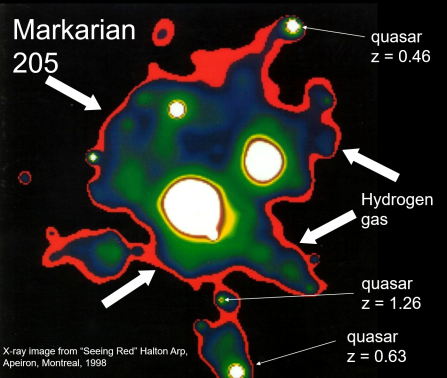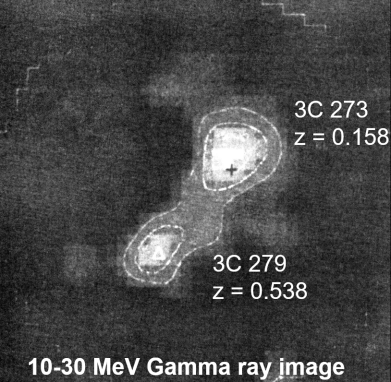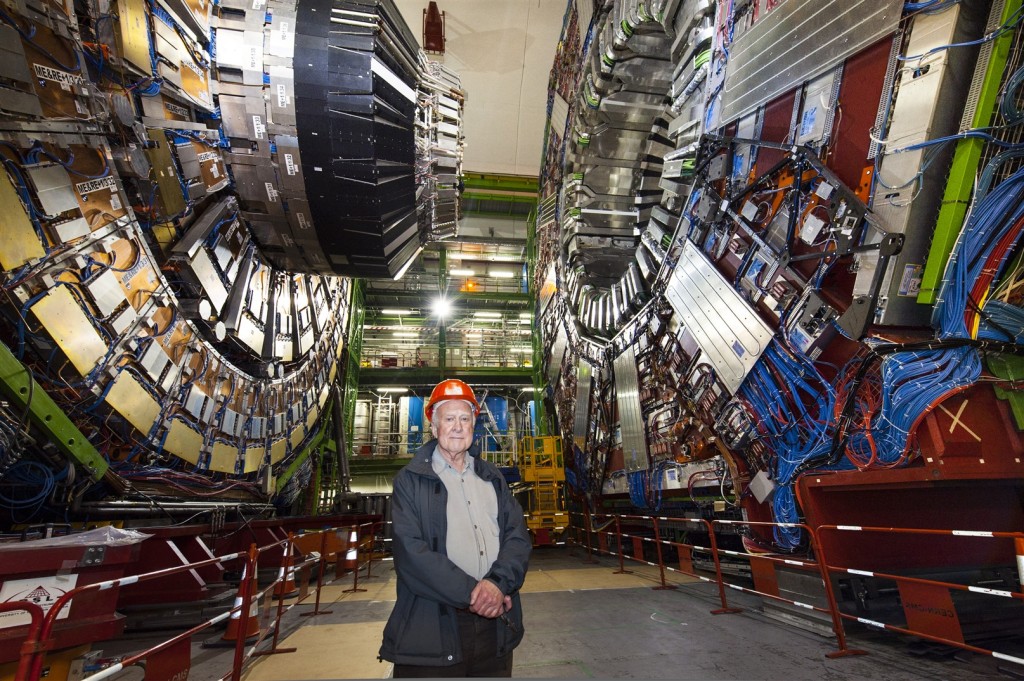
What can we say about the distances of quasars? This is an important question. According to standard big bang cosmology, due to cosmological expansion of the Universe, the very high redshifts of quasars place them at very great distances. If however even one example could be shown that contradicts the standard “greater the redshift the greater the distance” rule then it would undermine the fundamental foundation of the Standard Model of big bang cosmology. It follows that most of the very high redshift objects in the cosmos may not be so distant. And that would radically change our interpretation of the alleged big bang universe.
One such example that contradicts the Standard Model is shown in Fig. 1. The late Halton Arp spent his 60-year research career looking at peculiar galaxies, which he believed contradicted the standard big bang assumptions. Markarian 205 is such a peculiar galaxy within which are seen three quasars. Markarian 205 has a redshift of z = 0.07 but the quasars z = 1.26, 0.63 and 0.46. According to the Standard Model the high redshift quasars should be many billions of light-years behind Markarian 205, but they are clearly seen enveloped in the X-ray emitting hydrogen gas around the galaxy (as indicated by the white arrows).
Lyman-α forest
Arp’s hypothesis, that quasars and active galactic nuclei (AGNs1) have a very large intrinsic component to their redshifts, which is unrelated to their cosmic distance from Earth, is strongly rejected by the Standard Model (big bang) community. In relation to this question I received the following from a reader of my website.2
It is claimed, that the many lines of the Lyman alpha forest in the spectrum of most quasars prove that they are very far away. Also, it is claimed that increasing Lyman alpha forest lines is connected with increased magnitude of redshift, so supporting large distances. Is that observational true?
The argument for the Lyman-α (alpha) forest of spectral lines comes with several unprovable assumptions. It is assumed that there exist clouds of hydrogen gas between distant quasars and Earth that absorb ultraviolet light at the wavelength of the Lyman-α line of hydrogen, which is about 122 nm. Quasars also emit light in a strong Lyman-α emission line. The idea is illustrated in Fig. 2. The hydrogen gas clouds may be the surrounds of galaxies in the intervening space.
In the Standard Model a Hubble-law-like relationship is derived from the cosmology for all redshifts, resulting from cosmological expansion of the Universe. Hydrogen clouds are assumed to absorb light from the assumed background quasars, and thus it follows that in an expanding universe all hydrogen clouds have smaller redshifts than any chosen background quasar since the hydrogen clouds are not as distant. As a result the absorption lines are all on the blue or shorter wavelength side of the quasar emission line, as show below in Fig. 2.

Figure 2 shows a quasar with its Lyman-α emission line (peak) redshifted from the ultraviolet emission to a wavelength in the red end of the optical spectrum when received at the observer. Four Lyman-α absorption lines (dips) from four intervening clouds, which the light intersects on its journey to Earth, as the Universe expands, are shown in orange, yellow and green-blue. This illustrates the redshift of those clouds at different stages of the expansion history of the Universe and therefore by the Hubble law at distances proportional to their redshifts. In Fig. 2, the same Lyman α absorption line is seen at higher and higher redshifts, due to the expansion of the Universe, while the emission line of the quasar is seen in the red region of the spectrum instead of in the ultraviolet region where it would be for an un-redshifted spectrum.
Figure 3 shows two actual quasar spectra.3 The top one is from the nearby quasar 3C 273, the first historically to be detected, with a relatively small redshift (z = 0.158), and the bottom one is from a large redshift (z = 3.62) quasar Q1422+2309. The higher redshift spectrum (bottom panel) is shifted so that the emission line matches the lower redshift spectrum.
“The 3C 273 data are the average of two pre-refurbishment exposures totalling 49 minutes with HST’s Faint-Object Spectrograph. The spectacular data for 1422+2309 come from 7-hour Keck I HIRES spectrum at resolution of 6.6 km/s, which comprised 94,000 spectral pixels in the original data provided by Mike Rauch. The data have been averaged down to more closely match the 3C 273 results, and make the graph a little more legible.”3
If the hydrogen gas clouds that result in these absorption lines are much more numerous at high redshifts it would mean you should get a high density of many absorption lines. Thus this is called a forest and the bottom panel of Fig. 3 is said to illustrate this ‘fact’.

It has then been argued that the increasing trend of more absorption lines at greater redshift indicates more hydrogen clouds between source and observer, and this then is evidence that quasar redshifts are due to cosmological expansion. One astronomer, who argues against Arp’s intrinsic redshifts for quasars, writes:
“We know that there are a small number of very big clumps of hydrogen in the distant Universe: the galaxies. We also know that smaller galaxies, the dwarf galaxies, are very much more common. Most of the clouds in the Lyman alpha forest are much less massive than dwarf galaxies and these small clouds are much more numerous. We can only see these very low mass clouds by the absorption they produce in the strongest line of the most abundant element: Lyman alpha. Thus by studying the Lyman alpha forest we can learn about the density fluctuations in the Universe on the smallest observable scales.”4
But there seems to be some circularity in this argument. The forest is evidence for the existence of the many hydrogen clouds, but astronomers only ‘detect’ the existence of these clouds from the host of absorption lines in the forest. How do we know there are many small clouds between the quasars and the observer? The answer is the forest of absorption lines. Thus it follows that now we know the absorption lines indicate the existence of the hydrogen clouds, it is expected that they would generate many absorption lines at their respective redshift distances. The astronomer argues against Arp’s hypothesis as follows.
“Note that if Arp were correct and quasars had a redshift much larger than the redshift due to their distance, then there should be a gap on the blue side of the Lyman alpha emission line before the absorption lines began. Such gaps are not seen. So if Arp were correct the Lyman alpha forest would have to be an intrinsic property of the quasar, which would be a very unlikely situation. Distant galaxies are seen which also show the Lyman alpha forest, so we know that the intervening clouds do exist. For Arp to be correct the intrinsic absorption lines would have to act exactly like the intervening clouds would act under the standard hypothesis that the quasar redshift is entirely cosmological.”4
Arp’s hypothesis
Halton Arp and other astronomers proposed that quasars have an intrinsic component to their redshifts and thus those redshifts are not largely due to the expansion of the Universe. Arp and others admit the possibility of a Hubble-law like distance relationship for normal undisturbed galaxies but in the quasars and AGNs there is a strong intrinsic component. This has come about from their detection of quasar-galaxy associations.5 They found examples of where galaxies appeared to have quasars physically associated with them, even a quasar in the foreground of a low redshift galaxy.6 Arp proposed the ejection of quasars from the core of AGNs and as a result quasar redshifts are often found in pairs (with redshift values approximately the same) around a putative parent galaxy. Also it has been found that the quasar redshifts preferably are found at certain discrete values (0.062, 0.30, 0.60, 0.96, 1.41, 1.96, 2.64, …) named after Karlsson.7 Some lines of quasars are found with the same redshift at a big bang epoch where such structures should not exist.8
But the Lyman α forest may be a property of the quasars, and if so, it does not follow that it indicates a distance increase with an increase in density of absorption lines. This is discussed in a 2012 paper by Chris Fulton and Halton Arp, published in the leading astrophysics journal the Astrophysical Journal.9
“The standard model posits that the Lyα Forest is generated en route as radiation from a quasar passes through intervening galaxies leading to absorption at redshifts lower than the emission redshift of the quasar. The test of the theory comes from the redshifts distributed en route, which should match the distribution of intervening structures.
“On the other hand, the intrinsic redshift [Arp’s] hypothesis posits that the Lyα Forest comes from absorption in the quasar itself, presenting the question of how the forest arises. The variable mass hypothesis (Narlikar & Das 1980) would predict lower particle masses at younger age and therefore higher redshifts. If one is arguing for periodic (quantized) redshifts, then one would expect that after transforming to the rest frame of the host galaxy redshifts that the absorption line redshifts should show up at Karlsson values. This idea can be tested with the large databases available now, such as our investigation of the 2dF data.
“One then argues that a galaxy has multiple creation epochs and when light from a created quasar comes to the observer, it passes through clouds of matter created earlier than the quasar, so as to have lower redshift than the quasar, thus producing absorption redshifts. So, one testable prediction that can distinguish the Standard Model from our hypothesis is the distribution of absorption features in the Lyα Forest. In contrast to the Standard Model, our hypothesis predicts that absorption features will be distributed at Karlsson values. We propose that detailed observations and investigations could be made of the galaxy–quasar systems identified by our detection algorithm, using quasars at higher redshift that display the Lyα Forest, to ascertain if the redshifts of quasar absorption features are consistent with Karlsson redshifts, thus categorically distinguishing our hypothesis from the Standard Model.”
It would seem that Arp’s hypothesis is not ruled out by the Lyman-α forest observations in quasar spectra. I am not saying that the Standard Model hypothesis for the Lyman-α forest is unreasonable, but that it is not the only possible explanation.
In fact, the same old problem pops up again—that is, how do you know anything in the cosmos when you have no direct access to the cosmos as one might have in a laboratory experiment? There are potentially multiple mechanisms that might result in the same observations and how do you exclude all except the one that you decide is the correct one? In the case of the Standard Model of the big bang origin of the universe, it is now assumed to be true and all observations are now fitted into that belief system. That type of thinking has led to many crazy conclusions especially many dark fudge factors.10
Also, it is claimed that quasars have nebulosities around them contributing to the Lyman alpha forest lines. Are really most known quasars connected with galaxies or very close to them?2
The work of Arp on quasars associated with low redshift galaxies has shown a bridge of hydrogen connecting a quasar or an AGN to a spiral galaxy as in the case of the galaxies NGC 4319 and Markarian 205, shown in Figs 1 and 4, and a quasar in front of a spiral galaxy but entraining a jet of hydrogen gas from the nucleus of the spiral galaxy NGC 7319.6,11
At one stage NASA attempted to disprove the famous claim that Arp had made that the peculiar galaxy Markarian 205, with a redshift z = 0.07, was connected to the spiral galaxy NGC 4319, with a redshift of z = 0.007, by a luminous bridge of gas. Since their redshifts were different by a factor of 10 they also should be at distances differing by the same factor. The NASA image below was published in the magazine Astronomy in January 2003 (p.13) as evidence that they weren’t physically connected. However, on his website, Arp took the same image (Fig. 4(a)) reversed the colours (see Fig 4(b)), and showed the connection between the two galaxies from the same image.12

Arp published an X-ray image of Markarian 205 a disturbed AGN noting that it had several very high redshift quasars enveloped within its X-ray emitting hydrogen gas. See Fig. 1.

In some cases quasars are surrounded with gases and nebulosities. The observation of the nebulosity in a very high redshift quasar may in fact be an argument not for its great distance but its closeness to Earth.
The quasar 3C 273, which is very bright object that has long jets in two opposite directions, was imaged with the central brightness masked out using an eclipsing disk and the surrounding nebulosity was clearly revealed. This indicates that quasars, believed to be supermassive black holes, are embedded in galaxies, well, at least in some cases. See Fig. 5. The quasar 3C 273, as it turned out, resides in a giant elliptical galaxy.
The alternate hypothesis of the origin of galaxies, from Arp’s model, is that they are ejected as new plasma from the heart of a parent galaxy. After that they transition to normal galaxies as their redshifts reduce in quantized jumps towards the redshift z = 0.062.5

From this then it is not surprising that a) they have absorbing hydrogen gas in their surrounding nebulosities, and, b) as part of the mechanism of discrete redshifts that there might be some mechanism in that hydrogen gas that produces Lyman-α absorption lines on the blue side of their strong Lyman-a emission line. The existence of evidence for quantized quasar redshifts says that we are still some way away from fully understanding compact objects and their redshifts. Marmet maintains a web article where he lists possible redshift mechanisms, which at my last check was up to 59 different potential mechanisms13 that could produce a redshift and many result from effects in hydrogen gas. So it is plausible that the Lyman-a forest does indeed result from the quasar itself.
Quasars have been imaged in radiation from many different parts of the electromagnetic spectrum including gamma rays. Fig. 6 shows a gamma-ray image of 3C 273 and 3C 279, which seem to be embedded within the same gamma emitting gas. Their redshifts are different by a factor of 3.4 times yet they are seen to be part of the same nebulosity.
Conclusion
So there you have it. When other evidence is considered, besides the Lyman-α forest of absorption lines, there is evidence that contradicts the notion that the forest lines indicate the standard “the greater the redshift the greater the distance” rule in the cosmos. If that rule—known as the Hubble law at small redshifts—is not correct for quasars and AGNs then it undermines the fundamental foundation of the Standard Model of big bang cosmology—the expansion of the Universe. And if there was no expansion there was no big bang!
The Bible says: “In the beginning God [not the big bang] created the [universe]” (Genesis 1:1).
References and Notes
- AGNs are also quasar-like objects.
- Harald Heinze (of Switzerland), email dated March 26, 2016.
- Quasars as lighthouses: the Lyman-alpha forest at low and high redshift, accessed March 28, 2016.
- E.L. Wright, Lyman Alpha Forest, dated August 1, 2004; accessed March 28, 2016.
- J.G. Hartnett, Galaxy-quasar associations, January 1, 2014.
- J.G. Hartnett, Halton Arp—Big-bang-defying giant passes away, December 29, 2013.
- H. Arp, C. Fulton, D. Carosati, Intrinsic Redshifts in Quasars and Galaxies (PDF), http://www.haltonarp.com
- J.G. Hartnett, Four high redshift quasars puzzle astronomers, May 23, 2015.
- C.C. Fulton and H.C. Arp, The 2dF redshift survey. I. Physical association and periodicity in quasar families, Ap J 754:134-143, 2012; http://adsabs.harvard.edu/abs/2012ApJ…754..134F
- J.G. Hartnett, Big bang fudge factors, December 24, 2013.
- J.G. Hartnett, Quasar redshifts blast big bang, November 1, 2014.
- The Markarian 205 image itself is discussed in the video “Quasar redshifts blast big bang,” ref. 11, see around 5:50 mark.
- L. Marmet, On the Interpretation of Red-Shifts: A Quantitative Comparison of Red-Shift Mechanisms II, last updated February 26, 2016.






3 responses to “The distances to quasars”
Thanks for the interesting article. According to Wikipedia, “Most quasars were formed approximately 12 billion years ago, and they are normally caused by collisions of galaxies, with the galaxies’ central black holes merging to form either a supermassive black hole[3] or a binary black hole system.” If correct, perhaps the peculiar redshifts apparently intrinsic to the Quasars are the result of spacetime distortions nears their black-hole cores; and quantised redshift might be related to staged collapse to form the black holes.
LikeLike
I believe Hoyle, Burbidge and Fowler (1967) proposed a model that quasar redshifts were from a gravitational cause, which it seems is what you suggest. They suggested that a deep potential well was created by a cluster of very compact objects (perhaps neutron stars). This provided the situation for a large gravitational redshift. Bondi (1964) argued that it was not theoretically possible to get a redshift greater than 0.62 for a photon coming from the surface of a stable gravitatationally bound fluid. See Can the Redshifts of Quasi-Stellar Objects BE Gravitational? From subsequent theoretical analyses it would seem that the answer lies elsewhere, not with gravitational redshift. Then there is redshift quantisation thrown into the mix to make it even more of a challenge to understand.
LikeLike
Yes, the paper you have referenced describes the Hoyle-Fowler compact star cluster model which, while it overcomes the Bondi limit, has limitations of its own (stability, light interception, and “the way in which star clusters evolve”). However, supermassive black holes are a different animal, and perhaps not subject to the same limitations(?) The paper also refers to a star cluster distribution investigated by Einstein which, in the limit of infinite central density, could generate infinite redshift.
LikeLike